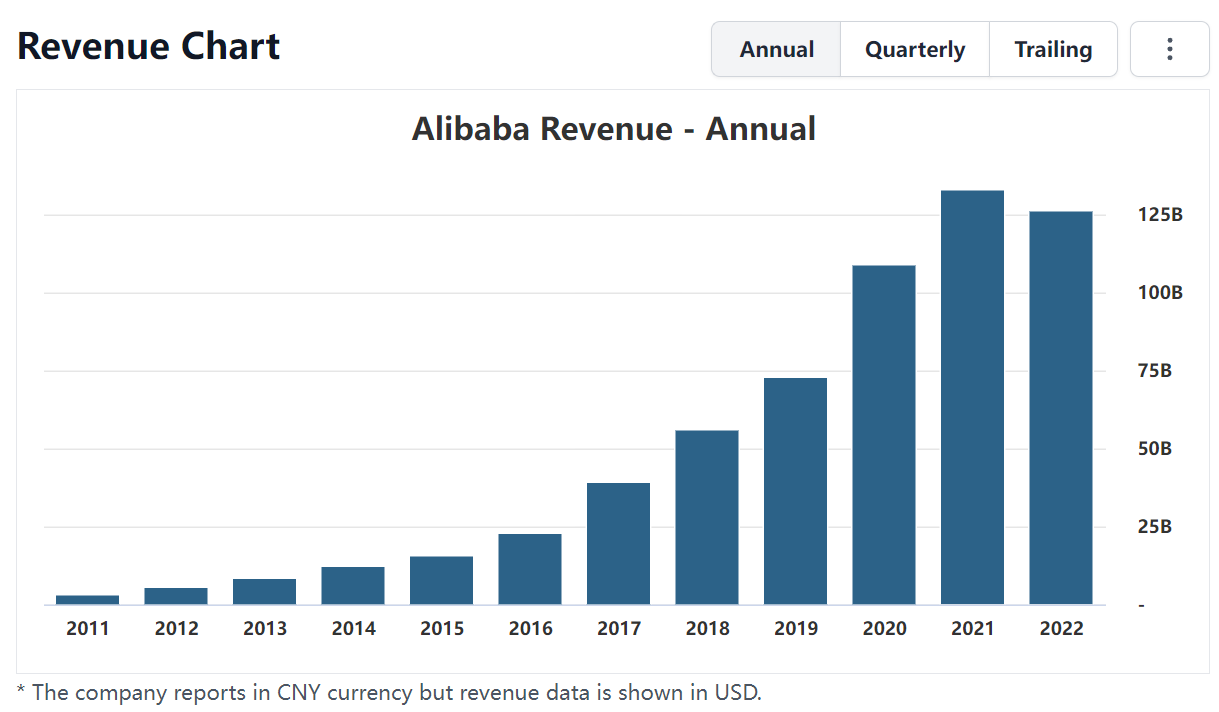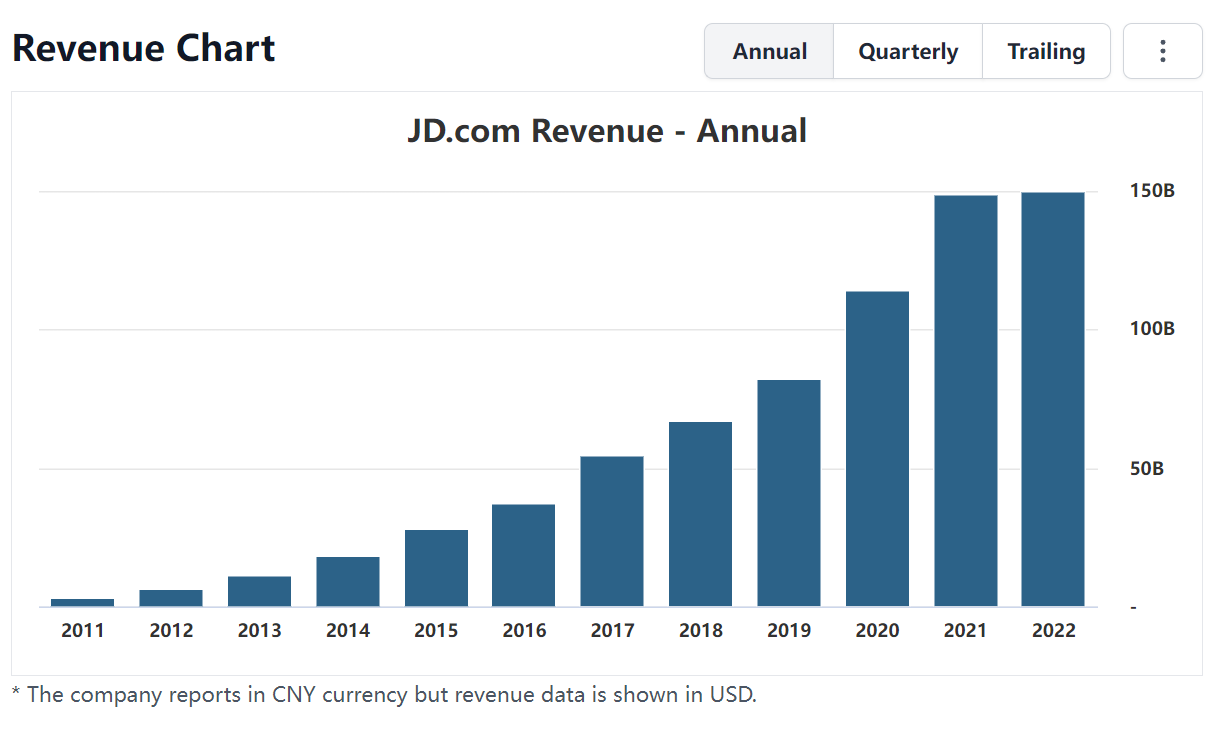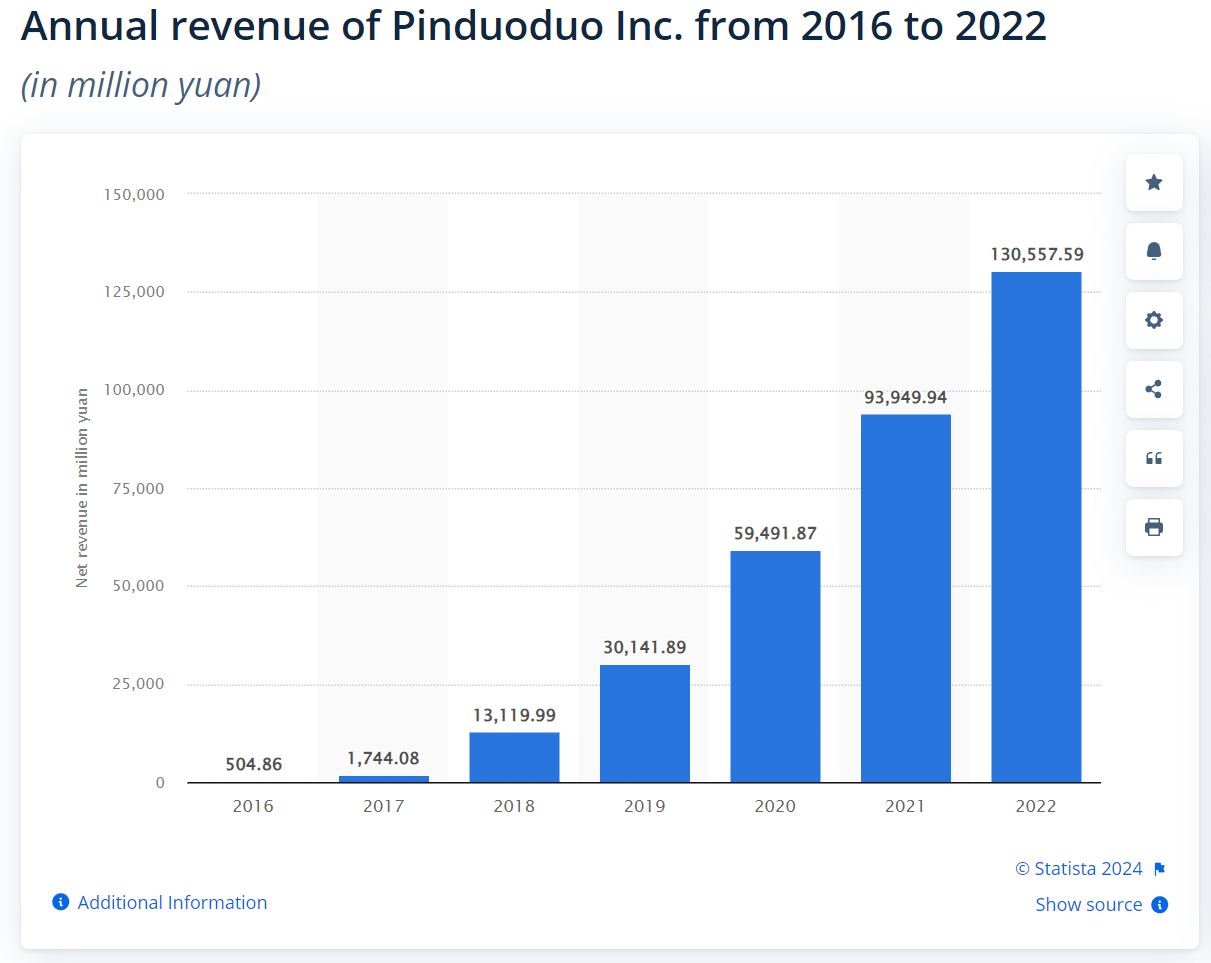1. Introduction
1.1. Brief History of Taobao
Founded by Alibaba Group in 2003, Taobao quickly became the cornerstone of e-commerce in the Chinese marketplace. A user-friendly interface and the pioneering introduction of Alipay succeeded in fostering trust, among other things, helping Taobao become China's foremost e-commerce platform [1].
As Taobao has grown, it has made a remarkable contribution to the democratization of commerce. Its inclusive nature has made the platform a catalyst for empowering individual entrepreneurs and small businesses, providing them with a favorable environment in which to thrive. This visionary approach has not only greatly expanded Taobao's user base, but has also facilitated the diversification of its product catalog, giving it an advantage in the highly competitive online commerce space [2].
1.2. Strategic B2C Evolution
While the C2C model had its merits, it inevitably resulted in the proliferation of inferior products. This not only affected Taobao's reputation, but also hindered its expansion. The openness of person-to-person transactions facilitated the entry of unscrupulous sellers and tarnished Taobao's image. To address this problem, Taobao made a crucial shift from a C2C (consumer-to-consumer) model to a strategic B2C (business-to-consumer) model. This shift marked a major change in Taobao's operational strategy and had a profound impact on the development of the platform and the e-commerce landscape as a whole.
Taobao's B2C evolution has consciously expanded the size of its marketplace and included businesses of all sizes. Taobao opened its doors to well-known brands and retailers, providing them with a channel to engage directly with consumers. This initiative facilitated a shift from individual peer-to-peer transactions to a more business-oriented framework, fostering a symbiotic relationship between sellers and consumers and giving Taobao a unique competitive advantage.
An essential aspect of this evolution is Taobao's dedication to building trust and credibility in its B2C ecosystem. The platform has implemented strict business certification measures to ensure that consumers can confidently transact with a wide range of sellers. By prioritizing trust, Taobao has enhanced its position as a reliable e-commerce platform and created an environment conducive to continued business growth.
In addition, the strategic integration of technology has played a critical role in enhancing the Taobao B2C experience. Advanced algorithms are used to personalize product recommendations, creating a customized shopping experience for individual consumers. A user-friendly interface further simplifies the buying process, creating a seamless and engaging online shopping environment. With these technological innovations, Taobao not only meets consumers' evolving expectations, but also fosters customer loyalty [3].
Tmall is the primary B2C division of Taobao and was officially launched in 2013. With the establishment of Tmall, Alibaba's revenue grew from $5.55 billion in 2013 to $8.64 billion in 2014, an increase of 52.66% in 2014 and 45.39% in 2015 [4].

Figure 1: Alibaba’s Revenue from 2011-2022 [4]
2. Taobao’s Major Innovative Marketing Initiatives
In tandem with its strategic expansion into the B2C realm, Taobao has strategically intensified its marketing efforts to drive sales. Recognizing the historical context of Chinese culture, which traditionally did not favor over-consumption, and considering the relatively modest GDP per capita in China at the beginning of the 21st century, Taobao embarked on a mission to reshape consumers' perspectives on shopping [5]. The crucial role of marketing becomes evident in this context as Taobao sought to navigate cultural norms and promote a more consumer-friendly outlook on commerce.
2.1. Double Eleven Phenomenon
The inception of the "Double Eleven" phenomenon in 2009 marks a pivotal moment in the evolution of Taobao and the broader e-commerce landscape in China. Recognized as Singles' Day due to the repetition of the number "1" in the date 11/11, this annual shopping event has grown exponentially in scale and significance.
The first Double Eleven event was launched by Taobao with the intention of increasing sales during a period of historically low retail sales. Originally conceptualized as a day for consumers to celebrate their singleness by making special purchases, the impact of Double Eleven has greatly exceeded expectations. in 2009, the inaugural Double Eleven event generated a staggering gross merchandise value (GMV) of over $8 million. This was followed by an exponential surge to $852 million in 2011, indicating a remarkable 10,650% increase over a two-year period [6].
The success of Double Eleven lies in its ability to generate unprecedented sales in a very short period of time. Taobao strategically implemented deep discounts, exclusive promotions and engaging marketing campaigns to attract consumers. This triggered a shopping frenzy as consumers scrambled to get in on the action in order to take advantage of great deals on a wide range of products. The scale of transactions during Double Eleven continues to set new records, making it a shopping event like Black Friday.
The Double Eleven shopping festival has huge strategic significance for Taobao. Not only is Double Eleven a day of amazing sales, but it has become a cultural and commercial phenomenon that is deeply rooted in Chinese consumer behavior. Double Eleven demonstrates Taobao's success in orchestrating large-scale promotions and reinforces the platform's importance in the e-commerce ecosystem. The success of Double Eleven solidifies Taobao's leadership position and enables it to capitalize on cultural events to drive huge business growth.
2.2. Live Commerce Innovation
In 2016, Taobao began a new live streaming business model, marking a groundbreaking development in the consumer space and a transformation of the consumer experience. This business model offers consumers a distinctive and interactive buying experience. In stark contrast to the traditional shopping steps of product exploration, detailed reading of product descriptions, and comparing similar items, Taobao's live streaming model allows product presenters to interact directly with consumers. This innovative model enhances the overall buying experience for consumers and increases their sense of urgency, thus contributing to significant growth in total revenue. This streamlined approach speeds up the buying process, enabling consumers to quickly initiate product shipments with a simple click after the influencer introduces the product. A careful analysis by McKinsey shows that sales facilitated through instant commerce platforms have the potential to account for 10 to 20 percent of the overall e-commerce market by 2026.[7]
Moreover, the integration of live commerce has proven instrumental in reducing the advertising costs incurred by brands, rendering them more appealing in the marketplace. In contrast to traditional advertising, wherein brands often allocate substantial financial resources toward hiring celebrities for product endorsements, live commerce offers a cost-effective alternative. Research indicates that in the realm of live commerce, even small-scale influencers can yield satisfactory profits. A survey reveals that the engagement rates for nano-influencers on platforms such as Instagram are ten times higher than those for mega and macro influencers. With this reduction in advertising expenditures, Taobao, as the preeminent live commerce platform in China, has become the preferred choice for numerous international brands.[7]
3. External Risks and the Competitive Landscape
3.1. Intense Market Competition
Competing with e-commerce giants such as JD.com and Pinduoduo is a tough challenge. JD.com stands out by emphasizing premium services, especially high-quality delivery services. This unique ecosystem position has allowed it to successfully differentiate itself from the e-commerce competition in China. In stark contrast, Pinduoduo, a leader in China's e-commerce space, focuses on low-priced products tailored to the lower end of the market and has gained a foothold in the sinking market. This commercial positioning, which focuses on cheap goods and second- and third-tier cities, has generated significant revenue growth for Pinduoduo.

Figure 2: JD.com Revenue from 2011-2022 [8]

Figure 3: Pinduoduo Inc. Revenue from 2016-2022 [9]
Against the backdrop of tough market competition, especially from e-commerce giants JD.com and Pinduoduo, Taobao has found itself having to constantly reform its diverse business model in order to maintain its competitive edge. The rapidly evolving market dynamics required not only strategic flexibility, but also proactive measures to ensure that Taobao maintained a prominent position in the face of fierce competition. Faced with strong challenges from JD.com at the high end of the market and Pinduoduo at the low end, Taobao is faced with the imperative of juggling different user segments to secure its leading position in China's e-commerce space.
3.2. Counterfeiting and Trust Issues
The problem of product counterfeiting includes the unauthorized copying and modification of trademarks belonging to well-known brands with the aim of exploiting the reputation of those brands. Taobao has greatly reduced the cost for sellers to set up stores and facilitated non-face-to-face interactions between customers and sellers, inadvertently creating a vast and convenient platform for unscrupulous individuals engaged in the sale of counterfeit products. Despite a certain degree of regulatory mechanisms, the prevalence of dubious sellers and the existence of various deceptive goods on Taobao still have a negative impact on Taobao's brand image that cannot be ignored. Taobao's reputation would take a serious hit if fake and shoddy products appeared on the platform in large numbers. New brand owners will also consider the impact of counterfeits when they move into Taobao, which is not conducive to Taobao's establishment of a good brand image as well as its expansion.
3.3. Price Wars and Discounts
Taobao is in the awkward position of having to cope with a relentless price war while relying heavily on discounts as a means of acquiring customers. While competitive pricing is critical to attracting a wide range of consumers, the constant pressure to reduce prices poses a significant threat to Taobao's profitability. The long-term balance between competitiveness and profitability has become a key issue, challenging the sustainability of Taobao's business model [10].
The e-commerce industry is highly competitive and consumers are price-sensitive, which aggravates Taobao's difficulty in differentiating itself from its competitors. Taobao's weaknesses are mainly reflected in its over-reliance on price as a key differentiator, which exposes it to the risk of low margins or even losses. This inherent challenge is accentuated by the fact that competitors have also adopted aggressive pricing strategies, creating a race to the bottom.
In the absence of an accurate pricing scheme, the pursuit of low prices can affect Taobao's bottom line and raise doubts about the long-term viability of maintaining such an aggressive pricing model. As a result, Taobao faces the challenge of finding a delicate balance that ensures competitiveness without jeopardizing the platform's financial viability. The dynamic nature of this challenge is further exacerbated by the changing expectations of consumers, whose loyalties can easily shift as competitors offer the lure of lower prices.
4. Strategic Solution: The Amazon Prime Membership Model
When considering the strategic evolution of Taobao, I took inspiration from the highly successful Amazon Prime membership program. Known for providing exclusive services such as expedited shipping, streaming services, and exclusive offers, Amazon Prime not only fostered customer loyalty, but also proved to be a reliable source of revenue for Amazon. Understanding the effectiveness of this model provides a foundation for Taobao's strategic development.
Inspired by the success of Amazon Prime, I proposed that Taobao launch a membership program in its ecosystem to create a seamless and engaging user experience. The proposed membership program is designed with a user-friendly interface that facilitates subscription management for customers. Emulating the effective structure of Amazon Prime, it introduces multiple tiers with exclusive benefits including fast shipping, early access to sales and personalized recommendations.
The core of this membership program is the introduction of a personalized user dashboard that showcases member status, benefits and upcoming exclusive offers. Empowering members to customize preferences and settings ensures a customized experience. In addition, the Taobao page can be seamlessly linked to the Taobao mobile app, improving accessibility and allowing members to learn about exclusive offers, early access and personalized recommendations through push notifications.
Taobao can use artificial intelligence and machine learning to enable data-driven personalization. Algorithms can analyze member data to provide highly personalized product recommendations, increasing customer engagement and purchase rates. Moreover, a trust assurance mechanism can be incorporated with the introduction of an " Authentication of Products" section to address issues related to product authenticity through strict quality control.
In addition, Taobao could introduce a section dedicated to exclusive offers and promotions, encouraging non-members to subscribe for more benefits. Collaborate with sellers to ensure Taobao has unique discounts and early access to the latest products. The subscription management interface should be intuitively designed to allow members to easily upgrade or downgrade and provide transparent information about subscription costs, renewal dates, and available offers.
The addition of streaming services could bring transformative innovation to Taobao's membership program. As digital entertainment plays an important role in the consumer experience, Taobao could hold exclusive live events, TV series, or other interactive experiences. This approach not only aligns with contemporary consumer preferences but also positions Taobao as a comprehensive lifestyle platform rather than just a shopping platform. By providing Taobao members with more usage scenarios and building user communities, Taobao can enhance the overall user experience and foster a deeper connection with the platform, strengthening user loyalty. The addition of the streaming service adds a layer of entertainment value that enhances the perceived benefits of the membership program and helps create a unique and compelling offering in a competitive e-commerce environment.
5. Conclusion
Consistent with Amazon Prime's strategic shift, Taobao's membership model shifts the strategic focus from meaningless price competition to exclusive offers and personalized service. This shift positions Taobao as a value provider that goes beyond mere price competition and helps build a more sustainable business model. By promoting exclusive offers and benefits, Taobao has been able to create a differentiated market position that attracts and retains customers based on value rather than price.
By offering more personalized services, Taobao has subtly established a distinctive market position, creating an environment that attracts and secures customers based on the intrinsic value of the product, thus transcending traditional price considerations. By placing itself in the streaming media as well as the offline community space, Taobao has not only succeeded in increasing its brand exposure and appeal to customers, but has also secured customer loyalty, laying a solid foundation for the long-term success of the business.
In conclusion, this research encapsulates the dynamic journey of Taobao, its success factors, and current challenges and proposes a strategic solution through the implementation of a membership model. The integration of this model, inspired by Amazon Prime, not only addresses existing challenges but also positions Taobao at the forefront of shaping the future of e-commerce in China.
References
[1]. Alibaba, Taobao, accessed February 20, 2024, https://www.alibabagroup.com/en-US/about-alibaba-businesses-1492004895883001856.
[2]. Niklas Lücke, "E-commerce in China: Taobao Village Phenomenon and Its Contribution to Sustainable Development," in E-commerce in China: Taobao Village Phenomenon and Its Contribution to Sustainable Development (NOVA – School of Business and Economics, 2021), 2, excerpt from Nova School of Business and Economics, http://hdl.handle.net/10362/123731.
[3]. Le-Ran Guan and Kyung-Tae Kim, "Comparative Analysis on Corporate Strategy of B2C E-Commerce in China: The Cases of JD.Com and Tmall," Journal of International Trade and Commerce 14 (July 23, 2018): 5, accessed February 20, 2024, http://dx.doi.org/10.16980/jitc.14.1.201802.119.
[4]. Stock Analysis, accessed February 20, 2024, https://stockanalysis.com/stocks/baba/revenue/.
[5]. Xinhua He and Yongfu Cao, "Understanding High Saving Rate in China," China and World Economy 15, no. 1 (2007): 3, https://doi.org/10.1111/j.1749-124x.2007.00049.x.
[6]. Elizabeth Utley, "15 Years of 11.11 at Alibaba: A Timeline," Alizila, last modified October 25, 2023, accessed February 20, 2024, https://www.alizila.com/15-years-11-11-alibaba-timeline/.
[7]. Arun Arora, "It's Showtime! How Live Commerce Is Transforming the Shopping Experience," McKinsey Digital, last modified July 21, 2021, accessed February 20, 2024, https://www.mckinsey.com/capabilities/mckinsey-digital/our-insights/its-showtime-how-live-commerce-is-transforming-the-shopping-experience.
[8]. "Stock Analysis," Stock Analysis, accessed February 20, 2024, https://stockanalysis.com/stocks/jd/revenue/.
[9]. "Annual Revenue of Pinduoduo Inc. from 2016 to 2022," Statista, accessed February 20, 2024, https://www.statista.com/statistics/1030499/pinduoduo-annual-revenue/.
[10]. Jiuping Xu et al., Proceedings of the Ninth International Conference on Management Science and Engineering Management (Berlin, Heidelberg: Springer, 2015), 511-520, accessed February 20, 2024, https://doi.org/10.1007/978-3-662-47241-5_43.
Cite this article
Lin,Z.(. (2024). E-Commerce Evolution in China: Taobao's Triumphs, Trials, and Strategic Advancements . Advances in Economics, Management and Political Sciences,80,337-344.
Data availability
The datasets used and/or analyzed during the current study will be available from the authors upon reasonable request.
Disclaimer/Publisher's Note
The statements, opinions and data contained in all publications are solely those of the individual author(s) and contributor(s) and not of EWA Publishing and/or the editor(s). EWA Publishing and/or the editor(s) disclaim responsibility for any injury to people or property resulting from any ideas, methods, instructions or products referred to in the content.
About volume
Volume title: Proceedings of the 3rd International Conference on Business and Policy Studies
© 2024 by the author(s). Licensee EWA Publishing, Oxford, UK. This article is an open access article distributed under the terms and
conditions of the Creative Commons Attribution (CC BY) license. Authors who
publish this series agree to the following terms:
1. Authors retain copyright and grant the series right of first publication with the work simultaneously licensed under a Creative Commons
Attribution License that allows others to share the work with an acknowledgment of the work's authorship and initial publication in this
series.
2. Authors are able to enter into separate, additional contractual arrangements for the non-exclusive distribution of the series's published
version of the work (e.g., post it to an institutional repository or publish it in a book), with an acknowledgment of its initial
publication in this series.
3. Authors are permitted and encouraged to post their work online (e.g., in institutional repositories or on their website) prior to and
during the submission process, as it can lead to productive exchanges, as well as earlier and greater citation of published work (See
Open access policy for details).
References
[1]. Alibaba, Taobao, accessed February 20, 2024, https://www.alibabagroup.com/en-US/about-alibaba-businesses-1492004895883001856.
[2]. Niklas Lücke, "E-commerce in China: Taobao Village Phenomenon and Its Contribution to Sustainable Development," in E-commerce in China: Taobao Village Phenomenon and Its Contribution to Sustainable Development (NOVA – School of Business and Economics, 2021), 2, excerpt from Nova School of Business and Economics, http://hdl.handle.net/10362/123731.
[3]. Le-Ran Guan and Kyung-Tae Kim, "Comparative Analysis on Corporate Strategy of B2C E-Commerce in China: The Cases of JD.Com and Tmall," Journal of International Trade and Commerce 14 (July 23, 2018): 5, accessed February 20, 2024, http://dx.doi.org/10.16980/jitc.14.1.201802.119.
[4]. Stock Analysis, accessed February 20, 2024, https://stockanalysis.com/stocks/baba/revenue/.
[5]. Xinhua He and Yongfu Cao, "Understanding High Saving Rate in China," China and World Economy 15, no. 1 (2007): 3, https://doi.org/10.1111/j.1749-124x.2007.00049.x.
[6]. Elizabeth Utley, "15 Years of 11.11 at Alibaba: A Timeline," Alizila, last modified October 25, 2023, accessed February 20, 2024, https://www.alizila.com/15-years-11-11-alibaba-timeline/.
[7]. Arun Arora, "It's Showtime! How Live Commerce Is Transforming the Shopping Experience," McKinsey Digital, last modified July 21, 2021, accessed February 20, 2024, https://www.mckinsey.com/capabilities/mckinsey-digital/our-insights/its-showtime-how-live-commerce-is-transforming-the-shopping-experience.
[8]. "Stock Analysis," Stock Analysis, accessed February 20, 2024, https://stockanalysis.com/stocks/jd/revenue/.
[9]. "Annual Revenue of Pinduoduo Inc. from 2016 to 2022," Statista, accessed February 20, 2024, https://www.statista.com/statistics/1030499/pinduoduo-annual-revenue/.
[10]. Jiuping Xu et al., Proceedings of the Ninth International Conference on Management Science and Engineering Management (Berlin, Heidelberg: Springer, 2015), 511-520, accessed February 20, 2024, https://doi.org/10.1007/978-3-662-47241-5_43.









